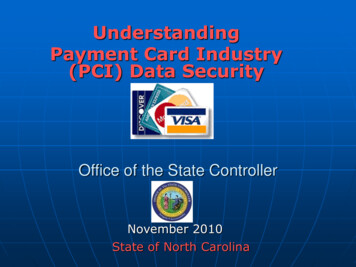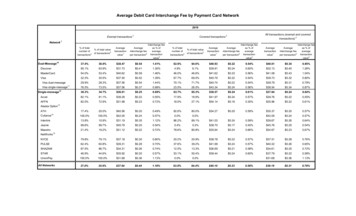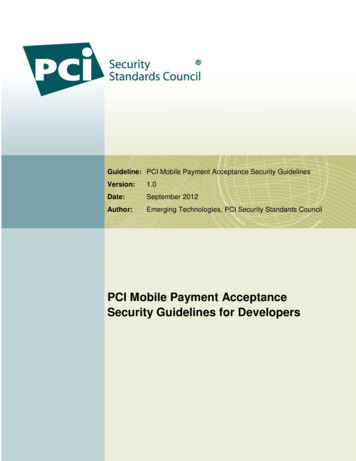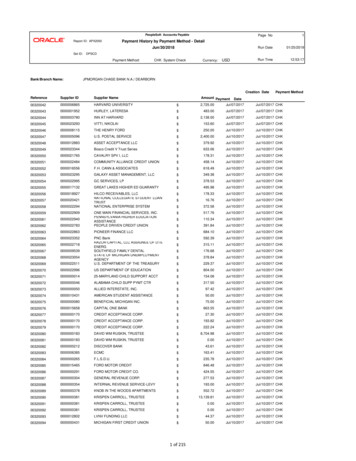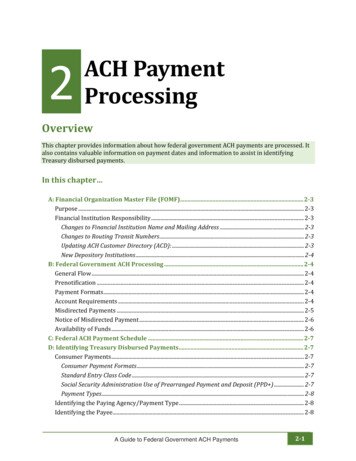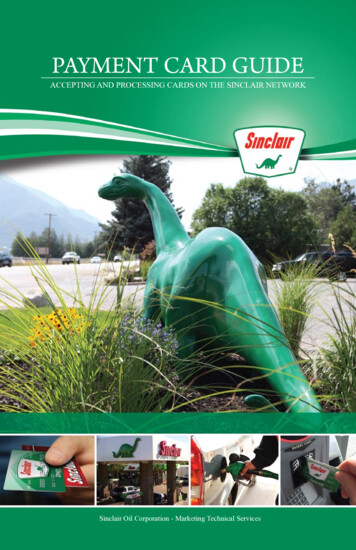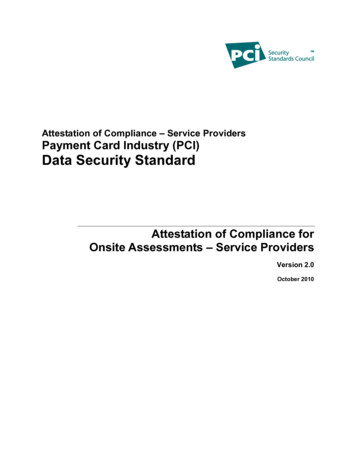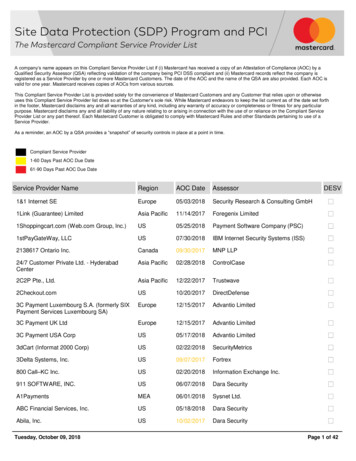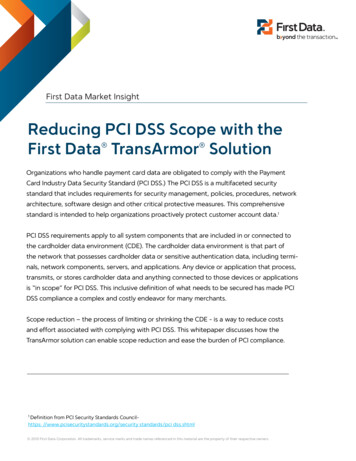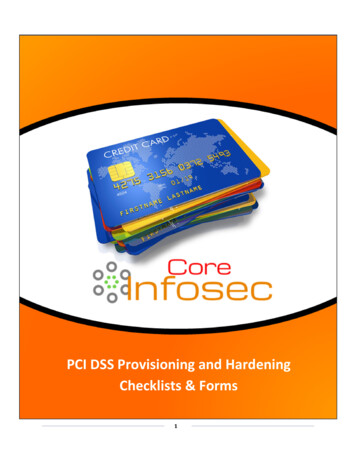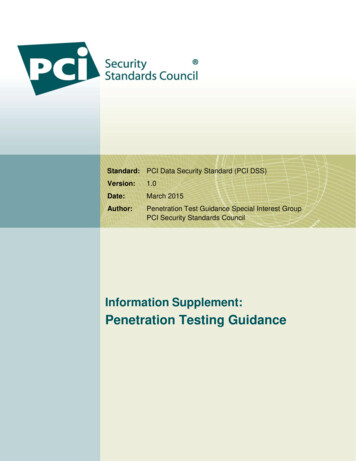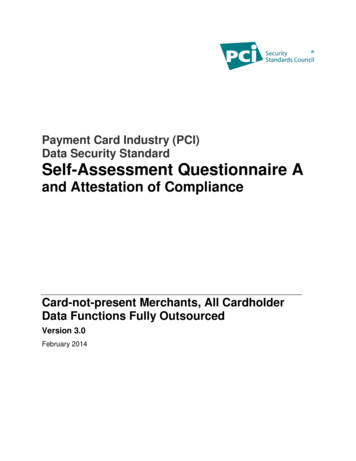
Transcription
Payment Card Industry (PCI)Data Security StandardSelf-Assessment Questionnaire Aand Attestation of ComplianceCard-not-present Merchants, All CardholderData Functions Fully OutsourcedVersion 3.0February 2014
Document ChangesDateVersionDescriptionOctober 20081.2To align content with new PCI DSS v1.2 and to implement minorchanges noted since original v1.1.October 20102.0To align content with new PCI DSS v2.0 requirements and testingprocedures.February 20143.0To align content with PCI DSS v3.0 requirements and testingprocedures and incorporate additional response options.PCI DSS SAQ A, v3.0 2006-2014 PCI Security Standards Council, LLC. All Rights Reserved.February 2014Page i
Table of ContentsDocument Changes . iBefore You Begin .iiiPCI DSS Self-Assessment Completion Steps . iiiUnderstanding the Self-Assessment Questionnaire . ivExpected Testing . ivCompleting the Self-Assessment Questionnaire . ivGuidance for Non-Applicability of Certain, Specific Requirements . vLegal Exception. vSection 1: Assessment Information . 1Section 2: Self-Assessment Questionnaire A. 4Requirement 9:Restrict physical access to cardholder data . 4Maintain an Information Security Policy . 6Requirement 12: Maintain a policy that addresses information security for all personnel . 6Appendix A: Additional PCI DSS Requirements for Shared Hosting Providers . 8Appendix B: Compensating Controls Worksheet . 9Appendix C: Explanation of Non-Applicability. 10Section 3: Validation and Attestation Details .11PCI DSS SAQ A, v3.0 2006-2014 PCI Security Standards Council, LLC. All Rights Reserved.February 2014Page ii
Before You BeginSAQ A has been developed to address requirements applicable to merchants whose cardholder datafunctions are completely outsourced to validated third parties, where the merchant retains only paperreports or receipts with cardholder data.SAQ A merchants may be either e-commerce or mail/telephone-order merchants (card-not-present), anddo not store, process, or transmit any cardholder data in electronic format on their systems or premises.SAQ A merchants confirm that, for this payment channel: Your company accepts only card-not-present (e-commerce or mail/telephone-order) transactions; All payment acceptance and processing are entirely outsourced to PCI DSS validated third-partyservice providers; Your company has no direct control of the manner in which cardholder data is captured, processed,transmitted, or stored; Your company does not electronically store, process, or transmit any cardholder data on yoursystems or premises, but relies entirely on a third party(s) to handle all these functions; Your company has confirmed that all third party(s) handling acceptance, storage, processing,and/or transmission of cardholder data are PCI DSS compliant; and Your company retains only paper reports or receipts with cardholder data, and these documentsare not received electronically.Additionally, for e-commerce channels: The entirety of all payment pages delivered to the consumer’s browser originates directly from athird-party PCI DSS validated service provider(s).This SAQ is not applicable to face-to-face channels.This shortened version of the SAQ includes questions that apply to a specific type of small merchantenvironment, as defined in the above eligibility criteria. If there are PCI DSS requirements applicable toyour environment that are not covered in this SAQ, it may be an indication that this SAQ is not suitable foryour environment. Additionally, you must still comply with all applicable PCI DSS requirements in order tobe PCI DSS compliant.PCI DSS Self-Assessment Completion Steps1. Identify the applicable SAQ for your environment – refer to the Self-Assessment QuestionnaireInstructions and Guidelines document on PCI SSC website for information.2. Confirm that your environment is properly scoped and meets the eligibility criteria for the SAQ youare using (as defined in Part 2g of the Attestation of Compliance).3. Assess your environment for compliance with applicable PCI DSS requirements.4. Complete all sections of this document: Section 1 (Part 1 & 2 of the AOC) – Assessment Information and Executive Summary. Section 2 – PCI DSS Self-Assessment Questionnaire (SAQ A) Section 3 (Parts 3 & 4 of the AOC) – Validation and Attestation Details and Action Plan forNon-Compliant Requirements (if applicable)5. Submit the SAQ and Attestation of Compliance, along with any other requested documentation—such as ASV scan reports—to your acquirer, payment brand or other requester.PCI DSS SAQ A, v3.0 2006-2014 PCI Security Standards Council, LLC. All Rights Reserved.February 2014Page iii
Understanding the Self-Assessment QuestionnaireThe questions contained in the “PCI DSS Question” column in this self-assessment questionnaire arebased on the requirements in the PCI DSS.Additional resources that provide guidance on PCI DSS requirements and how to complete the selfassessment questionnaire have been provided to assist with the assessment process. An overview ofsome of these resources is provided below:DocumentIncludes:PCI DSS Guidance on Scoping(PCI Data Security StandardRequirements and Security AssessmentProcedures) Guidance on the intent of all PCI DSS Requirements Details of testing procedures Guidance on Compensating ControlsSAQ Instructions and Guidelinesdocuments Information about all SAQs and their eligibility criteria How to determine which SAQ is right for yourorganizationPCI DSS and PA-DSS Glossary ofTerms, Abbreviations, and Acronyms Descriptions and definitions of terms used in the PCIDSS and self-assessment questionnairesThese and other resources can be found on the PCI SSC website (www.pcisecuritystandards.org).Organizations are encouraged to review the PCI DSS and other supporting documents before beginningan assessment.Expected TestingThe instructions provided in the “Expected Testing” column are based on the testing procedures in thePCI DSS, and provide a high-level description of the types of testing activities that should be performed inorder to verify that a requirement has been met. Full details of testing procedures for each requirementcan be found in the PCI DSS.Completing the Self-Assessment QuestionnaireFor each question, there is a choice of responses to indicate your company’s status regarding thatrequirement. Only one response should be selected for each question.A description of the meaning for each response is provided in the table below:ResponseYesYes with CCW(CompensatingControl Worksheet)When to use this response:The expected testing has been performed, and all elements of therequirement have been met as stated.The expected testing has been performed, and the requirement hasbeen met with the assistance of a compensating control.All responses in this column require completion of a CompensatingControl Worksheet (CCW) in Appendix B of the SAQ.Information on the use of compensating controls and guidance on howto complete the worksheet is provided in the PCI DSS.PCI DSS SAQ A, v3.0 2006-2014 PCI Security Standards Council, LLC. All Rights Reserved.February 2014Page iv
ResponseWhen to use this response:NoSome or all elements of the requirement have not been met, or are inthe process of being implemented, or require further testing before it willbe known if they are in place.N/AThe requirement does not apply to the organization’s environment. (SeeGuidance for Non-Applicability of Certain, Specific Requirements belowfor examples.)(Not Applicable)All responses in this column require a supporting explanation inAppendix C of the SAQ.Guidance for Non-Applicability of Certain, Specific RequirementsIf any requirements are deemed not applicable to your environment, select the “N/A” option for thatspecific requirement, and complete the “Explanation of Non-Applicability” worksheet in Appendix C foreach “N/A” entry.Legal ExceptionIf your organization is subject to a legal restriction that prevents the organization from meeting a PCI DSSrequirement, check the “No” column for that requirement and complete the relevant attestation in Part 3.PCI DSS SAQ A, v3.0 2006-2014 PCI Security Standards Council, LLC. All Rights Reserved.February 2014Page v
Section 1: Assessment InformationInstructions for SubmissionThis document must be completed as a declaration of the results of the merchant’s self-assessment with thePayment Card Industry Data Security Standard Requirements and Security Assessment Procedures (PCIDSS). Complete all sections: The merchant is responsible for ensuring that each section is completed by therelevant parties, as applicable. Contact acquirer (merchant bank) or the payment brands to determine reportingand submission procedures.Part 1. Merchant and Qualified Security Assessor InformationPart 1a. Merchant Organization InformationCompany Name:DBA (doingbusiness as):Contact Name:Title:ISA Name(s) (if applicable):Title:Telephone:E-mail:Business Address:City:State/Province:Country:Zip:URL:Part 1b. Qualified Security Assessor Company Information (if applicable)Company Name:Lead QSA Contact Name:Title:Telephone:E-mail:Business Address:City:State/Province:Country:Zip:URL:Part 2. Executive SummaryPart 2a. Type of Merchant Business (check all that apply)RetailerTelecommunicationGrocery and SupermarketsPetroleumE-CommerceMail order/telephone order (MOTO)Others (please specify):What types of payment channels does your businessserve?Which payment channels are covered by this SAQ?Mail order/telephone order (MOTO)Mail order/telephone order (MOTO)E-CommerceE-CommerceCard-present (face-to-face)Card-present (face-to-face)Note: If your organization has a payment channel or process that is not covered by this SAQ, consult youracquirer or payment brand about validation for the other channels.PCI DSS SAQ A, v3.0 – Section 1: Assessment Information 2006-2014 PCI Security Standards Council, LLC. All Rights Reserved.February 2014Page 1
Part 2b. Description of Payment Card BusinessHow and in what capacity does your businessstore, process and/or transmit cardholder data?Part 2c. LocationsList types of facilities and a summary of locations included in the PCI DSS review (for example, retail outlets,corporate offices, data centers, call centers, etc.)Type of facilityLocation(s) of facility (city, country)Part 2d. Payment ApplicationDoes the organization use one or more Payment Applications?YesNoProvide the following information regarding the Payment Applications your organization uses:Payment ApplicationNameVersionNumberApplicationVendorIs applicationPA-DSS Listed?YesNoYesNoYesNoPA-DSS Listing Expirydate (if applicable)Part 2e. Description of EnvironmentProvide a high-level description of the environment covered bythis assessment.For example: Connections into and out of the cardholder data environment(CDE). Critical system components within the CDE, such as POSdevices, databases, web servers, etc., and any othernecessary payment components, as applicable.Does your business use network segmentation to affect the scope of your PCI DSSenvironment?(Refer to “Network Segmentation” section of PCI DSS for guidance on network segmentation)PCI DSS SAQ A, v3.0 – Section 1: Assessment Information 2006-2014 PCI Security Standards Council, LLC. All Rights Reserved.YesNoFebruary 2014Page 2
Part 2f. Third-Party Service ProvidersDoes your company share cardholder data with any third-party service providers (for example,gateways, payment processors, payment service providers (PSP), web-hosting companies,airline booking agents, loyalty program agents, etc.)?YesNoIf Yes:Name of service provider:Description of services provided:Note: Requirement 12.8 applies to all entities in this list.Part 2g. Eligibility to Complete SAQ AMerchant certifies eligibility to complete this shortened version of the Self-Assessment Questionnairebecause, for this payment channel:Merchant accepts only card-not-present (e-commerce or mail/telephone-order) transactions);All payment acceptance and processing are entirely outsourced to PCI DSS validated third-partyservice providers;Merchant has no direct control of the manner in which cardholder data is captured, processed,transmitted, or stored;Merchant does not electronically store, process, or transmit any cardholder data on merchant systemsor premises, but relies entirely on a third party(s) to handle all these functions;Merchant has confirmed that all third party(s) handling acceptance, storage, processing, and/ortransmission of cardholder data are PCI DSS compliant; andMerchant retains only paper reports or receipts with cardholder data, and these documents are notreceived el
Section 2 – PCI DSS Self-Assessment Questionnaire (SAQ A) Section 3 (Parts 3 & 4 of the AOC) – Validation and Attestation Details and Action Plan for Non-Compliant Requirements (if applicable) 5. Submit the SAQ and Attestation of Compliance, along with any other requested documentation—
